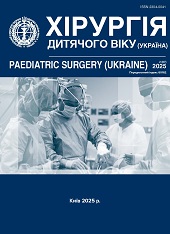Analysis of infection prevention and control programs in Ukrainian healthcare institutions providing transplantation services: challenges and priorities
DOI:
https://doi.org/10.15574/PS.2025.2(87).1215Keywords:
infection control, infection prevention, healthcare-associated infections, transplantationAbstract
Transplantation services in Ukraine are a rapidly developing area of healthcare. It is important to ensure the implementation of best practices in infection prevention and control (IPC) at the national and institutional levels to minimize the risk of complications. Healthcare-associated infections (HAIs) are common adverse event in transplant settings due to the various risk factors patients face, including immunosuppression, long and complex surgical procedures, and a number of other factors.
Аim - to analyze the IPC programs in Ukrainian healthcare institutions providing transplantation services.
Materials and methods. To assess the implementation of IPC programs at the facility level, a special questionnaire was developed for 31 centers and ten visits were conducted to transplant centers to analyze current practices.
Results. The following key components of IPC are best implemented in most hospitals: IPC environment, IPC materials and equipment, IPC guidelines. HAIs surveillance, multimodal strategies, monitoring of IPC practices, and IPC training in most of the transplant centers assessed need improvement. Not all health care facilities have access to 24-hour bacteriological laboratory services. In over 30% of transplant centers, reprocessing of medical equipment is carried out in inadequate conditions. 58% of operating rooms meet ISO (International Organization for Standardization) cleanroom class 6 requirements, 75% of patient rooms meet cleanroom standards.
Conclusions. The analysis of the IPC program in Ukrainian healthcare institutions providing transplantation services demonstrated heterogeneity in the implementation of IPC measures and significant challenges that healthcare institutions are facing. Priority areas for the development of the IPC program in transplant centers in Ukraine were identified.
No conflict of interests was declared by the authors.
References
Abdo-Cuza AA, Gómez-Bravo MA, Pérez-Bernal JB, Suárez-López J, Gómez-Peire F, Leiva-Torres JL et al. (2020, Mar). Health Care-Associated Infection in Solid Organ Transplant Recipients. Transplant Proc. 52(2): 509-511. Epub 2020 Feb 5. https://doi.org/10.1016/j.transproceed.2019.12.010; PMid:32035674
Anesi JA, Blumberg EA, Abbo LM. (2018, Jan). Perioperative Antibiotic Prophylaxis to Prevent Surgical Site Infections in Solid Organ Transplantation. Transplantation. 102(1): 21-34. https://doi.org/10.1097/TP.0000000000001848; PMid:28614192
MOZ Ukrainy. (2024). Statystyka provedennia transplantatsii za 9 misiatsiv 2024 roku. URL: https://utcc.gov.ua/statystyka-provedennya-transplantatsij-za-9-misyatsiv-2024-roku/.
World Health Organization. (2009). WHO guidelines on hand hygiene in health care: First Global Patient Safety Challenge - Clean Care is Safer Care. Geneva.
World Health Organization. (2016). Decontamination and reprocessing of medical devices for health-care facilities. Geneva.
World Health Organization. (2016). Guidelines on core components of infection prevention and control programmes at the national and acute healthcare facility level. Geneva. Licence: CC BY-NC-SA 3.0 IGO.
World Health Organization. (2018). Global guidelines for the prevention of surgical site infection, 2nd ed. World Health Organization.
Downloads
Published
Issue
Section
License
Copyright (c) 2025 Paediatric Surgery (Ukraine)

This work is licensed under a Creative Commons Attribution-NonCommercial 4.0 International License.
The policy of the Journal “PAEDIATRIC SURGERY. UKRAINE” is compatible with the vast majority of funders' of open access and self-archiving policies. The journal provides immediate open access route being convinced that everyone – not only scientists - can benefit from research results, and publishes articles exclusively under open access distribution, with a Creative Commons Attribution-Noncommercial 4.0 international license(СС BY-NC).
Authors transfer the copyright to the Journal “PAEDIATRIC SURGERY.UKRAINE” when the manuscript is accepted for publication. Authors declare that this manuscript has not been published nor is under simultaneous consideration for publication elsewhere. After publication, the articles become freely available on-line to the public.
Readers have the right to use, distribute, and reproduce articles in any medium, provided the articles and the journal are properly cited.
The use of published materials for commercial purposes is strongly prohibited.

